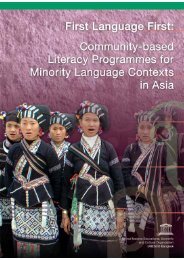Part II.pdf - MTB-MLE Network
Part II.pdf - MTB-MLE Network
Part II.pdf - MTB-MLE Network
Create successful ePaper yourself
Turn your PDF publications into a flip-book with our unique Google optimized e-Paper software.
the indigenous language speakers use Assamese as the language of communication when dealing<br />
with people of other language groups. Assamese can be easily used to express their language, and<br />
the people already know Assamese both in the written and spoken form. Besides, many Assamese<br />
words are common to the Rabha language.<br />
Process of developing teaching/learning materials<br />
Objectives of the Programme:<br />
The Rabhas have not had the opportunity to learn in their mother tongue like some other tribes,<br />
such as the Garo and Bodo. When SRC Assam thought of starting literacy in the Rabha language,<br />
it had to face several issues that needed special attention:<br />
• Of the eight Rabha sub-groups, only three have retained their mother tongue.<br />
• Of these three sub-groups, Rangdani and Maitori have 99% similarity, but Kochas has<br />
only 50% similarity with the other two.<br />
• The other five sub-groups have mostly forgotten their languages, and have accepted the<br />
mainstream Assamese language.<br />
• These five sub-groups are keen to revive their own language.<br />
• The Rabha Literary Society and the Rabha Cultural Society is working towards<br />
revitalisation and spread of the language and culture.<br />
In the above circumstances, SRC felt that in the Adult Literacy Programme, the opportunity to learn<br />
in their mother tongue should be given. Thus, to provide a chance to re-learn their own language,<br />
some motivational bilingual materials should be made available to the five sub-groups in order to<br />
create a favourable atmosphere.<br />
Methodology<br />
Under the initiative of a field investigator, Prabhat Bania, identification of the Rabha populated<br />
areas in the districts of Assam was successfully carried out. Bania collected the addresses of the<br />
people in the Rabha community. The textbooks used in the Rabha primary schools were also collected.<br />
Further interaction with the Rabhas began. As a second step, SRC Assam held a one-day awareness<br />
camp on October 18, 2002 at Agia, Goalpara to highlight the project for the Rabha community,<br />
and to identify writers/participants for the upcoming workshop. The meeting also resolved to<br />
communicate with Don Bosco School of Guwahati and SIL to gather information about the Rabha<br />
language. At that meeting, SRC Assam resolved to organize a five-day residential material preparation<br />
workshop from November 9-13, 2002 at a suitable venue in either Dudhnoi or Goalpara. The meeting<br />
decided to invite some noted writers representing Bongaigaon, Goalpara, Meghalaya, Dhemaji,<br />
Darrang and Kokrajhar.<br />
Materials Production Workshop<br />
Supplementary Materials: At the workshop, the writers belonging to different sub-tribes of the<br />
Rabha community and from different disciplines, areas, subjects and fields, assembled to prepare<br />
176
















